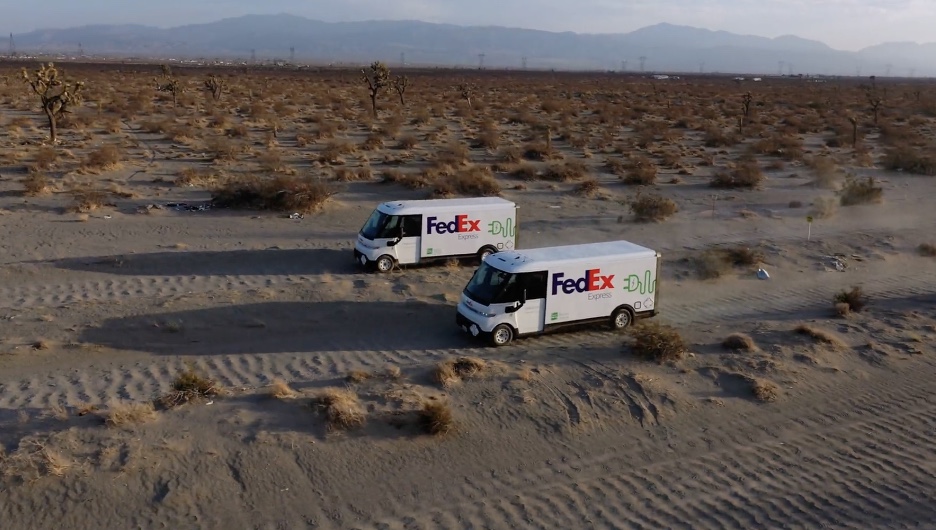
If you’ve been driving around Southern California lately, you may have noticed new electric vans in the FedEx fleet. They do look different than other vans on the streets. That’s because they’re new to the market, a General Motors electric van called the BrightDrop Zero.
As the first customer to receive BrightDrop Zevo 600, FedEx’s initial 150 vans have been deployed in Southern California. The electric vans have zero tailpipe emission, 600+ cubic feet of cargo room, and up to 250 miles on a fully charged battery. It comes with GM’s Ultium battery platform, that’s dedicated to bringing as much power, range, and performance as possible for a last-mile logistics urban vehicle.
Other features include connectivity through GM’s OnStar, advanced safety features to keep drivers safe, low step-in height, and large infotainment screens for a tech-enabled driving experience.
The 2024 BrightDrop Zevo 600 has a cargo volume of 614.7 cu. ft., a wheelbase of 183.5 inches, and an overall length of 290.0 inches. It’s starting price comes in at $64,425 after cash offers. The 2024 BrightDrop Zevo 400 starts at $62,725 after cash offers. Its specs are: 412.1 cu. ft. in cargo volume, a wheelbase of 153.1 inches, and overall length of 238.6 inches.
GM has an expanding network of BrightDrop dealers — seven of them for now.
FedEx is heading toward its goal of an all electric pickup and delivery fleet by 2040 — a very serious goal for a fleet currently at about 200,000 vehicles.
The delivery giant is is collaborating with Ford Pro to pilot ten Ford E-Transit vans. The vehicles are being tested in nine markets in the US to assess performance in different road and weather conditions. The Ford E-Transit has a targeted range of 126 miles on a single charge, making it ideal for FedEx’s targets in local courier delivery.
Rivian’s electric vans have hit a bit of a snag, with a shortage of parts causing a temporarily suspended production of its commercial delivery vans used by Amazon. It’s part of a series of supply chains for the electric truck and van maker, coming from supplier shortages.
The company produces all its vehicles at its factory in Normal, Illinois, with a second assembly plant planned in Georgia. The Illinois factory isn’t lacking in parts that will keep other Rivian vehicles in production, including its R1S SUV and R1T pickup models.
Amazon said it’s aware of of Rivian’s ‘short-term production issues this month,” but does not expect it to have an impact on its plan to bring the electric vans into its fleet.
Fleet operators are concerned about battery shortages that are limiting EV supplies and keeping prices high. There’s also concerns being voiced that startup electric van makers may be running out of money and shutting down. Electric vehicle production has always been a difficult segment to enter on the passenger and commercial segments, and fleets are taking a careful look at their options.
And in other news……….
Hybrids coming back: Last month, Ford reported that it decided to increase its output of gas-electric hybrid models, which has been seeing increased demand from car shoppers. One variant, which Ford calls extended-range electric vehicles, or EREVs, have done well in China and will be part of the U.S. strategy. These vehicles use a small gasoline engine to keep an on-board battery charged while driving, which produces longer driving range. Ford is also thinking about adding extended-range EV technology for its next-generation three-row SUVs, as it looks at offering a range of powertrain options throughout its vehicle lineup.
Hyundai Motor America announced that it will take a similar turn. With demand for electric vehicles slowing in the market, hybrids are seeing a comeback. According to Motor Authority, Hyundai said that in the future, large and luxury models from its Genesis subsidiary will also offer hybrid powertrains. The Korean automaker thinks that some of its future hybrids will benefit from improved brake energy regeneration and vehicle-to-grid technologies. In particular, it said it will offer an extended-range plug-in hybrid that will be able to travel up to 500 miles without needing to recharge or refuel.
Will U.S. hike China tariffs?: It’s been months since the Biden administration announced raising tariffs on China, including 100% electric vehicle duties, a 50% tariff on semiconductors and solar cells, and 25% on critical lithium-ion battery minerals. This delay may have had something to do with White House National Security Advisor Jake Sullivan recently visiting Beijing and speaking with several senior Chinese officials. Automotive News also reported that the visit included time spent with Chinese President Xi Jinping; both sides emphasized the need to manage the U.S.-China relationship, according to the reporting.



